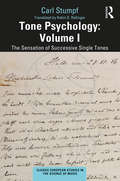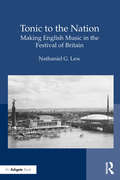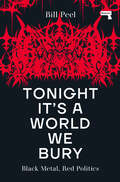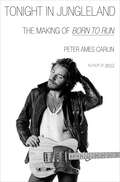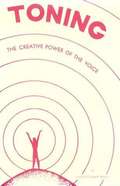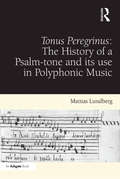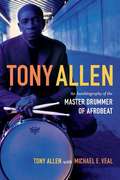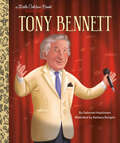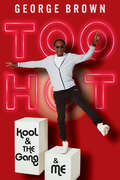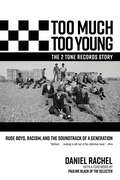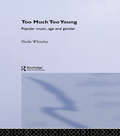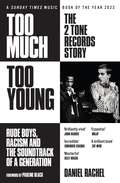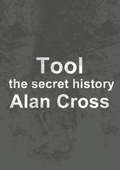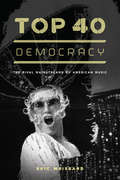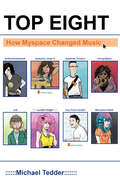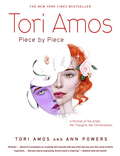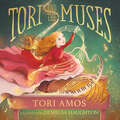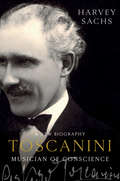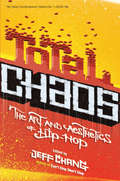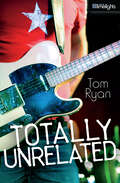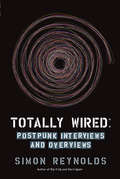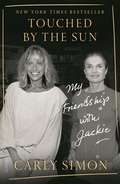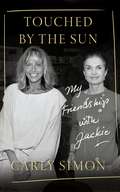- Table View
- List View
Tone Psychology: The Sensation of Successive Single Tones (Classic European Studies in the Science of Music)
by Carl StumpfCarl Stumpf (1848-1936) was a German philosopher and psychologist and a visionary and important academic. During his lifetime, he ranked among the most prominent scientists of his time. Stumpf's intention, as evident in his book, Tone Psychology, was to investigate the phenomenon of tone sensation in order to understand the general psychic functions and processes underlying the perception of sound and music. It could be argued that modern music psychology has lost or perhaps ignored the epistemological basis that Carl Stumpf developed in his Tone Psychology. To gain a confident psychological basis, the relevance of Stumpf's deliberations on music psychology cannot be overestimated. Analyses of the essence of tones, complex tones and sounds are fundamental topics for general psychology and epistemology. By the end of this two-volume work, Stumpf had established an epistemology of hearing. The subject of Volume I is the sensation of successive single tones. Stumpf demonstrates that analysis leads to the realisation of a plurality (is there only one tone or are there several tones?), which is then followed by a comparison: an increase may be observed (one tone is higher than the other) or a similarity may be realised (both tones have the same pitch or the same loudness). With almost mathematical stringency, Stumpf developed a topology of tones. Volume II deals with the sensation of two simultaneous tones (musical intervals). The books are stimulating, rewarding and provocative and will appeal to music psychologists, music theorists, general psychologists, philosophers, epistemologists and neuroscientists.
Tonic to the Nation: Making English Music in the Festival of Britain
by Nathaniel G. LewLong remembered chiefly for its modernist exhibitions on the South Bank in London, the 1951 Festival of Britain also showcased British artistic creativity in all its forms. In Tonic to the Nation, Nathaniel G. Lew tells the story of the English classical music and opera composed and revived for the Festival, and explores how these long-overlooked components of the Festival helped define English music in the post-war period. Drawing on a wealth of archival material, Lew looks closely at the work of the newly chartered Arts Council of Great Britain, for whom the Festival of Britain provided the first chance to assert its authority over British culture. The Arts Council devised many musical programs for the Festival, including commissions of new concert works, a vast London Season of almost 200 concerts highlighting seven centuries of English musical creativity, and several schemes to commission and perform new operas. These projects were not merely directed at bringing audiences to hear new and old national music, but to share broader goals of framing the national repertory, negotiating between the conflicting demands of conservative and progressive tastes, and using music to forge new national definitions in a changed post-war world.
Tonight It’s a World We Bury: Black Metal, Red Politics
by Bill PeelTonight It&’s a World We Bury explores a range of tendencies central to black metal and uncovers their potential as critiques of capitalism.Tonight It's a World We Bury is a radical re-writing of the history and politics of black metal music.Challenging the commonly-held perception that black metal is a genre of the right — full of wannabe Vikings, Nazis, skinheads and other unsavoury characters — Tonight It's a World We Bury looks at an array of black metal artists to re-affirm the genre as radically anticapitalist, revolutionary and left-wing.Utilizing an eclectic range of black metal bands, including Darkthrone, Burzum, Liturgy and Deathspell Omega, and taking in the works of Marx, Nietzsche, Deleuze and more, Tonight It's a World We Bury is a book on black metal like no other.
Tonight in Jungleland: The Making of Born to Run
by Peter Ames CarlinA fascinating behind-the-scenes account of the making of Bruce Springsteen’s ground-breaking album, Born to Run – one of the most iconic records in rock history – Tonight in Jungleland combines lush music writing with unprecedented inside access to Springsteen, his bandmates, and the full story behind every song… and coincides with the album’s 50th anniversary in August 2025. <p> From the opening piano notes of “Thunder Road,” to the final outro of “Jungleland” – with American anthems like “Born to Run” and “Tenth Avenue Freeze Out” in between – Bruce Springsteen’s seminal album, Born to Run, established Springsteen as a creative force in rock and roll. With his back against the wall, he wrote what has been hailed as a perfect album, a defining moment, and a roadmap for what would become a legendary career. <p> Peter Ames Carlin, whose bestselling biography, Bruce, gave him rare access to Springsteen’s inner circle, now returns with the full story of the making of this epic album. Released in August, 1975, Born to Run now celebrates its 50th anniversary. Carlin reveals a treasure trove of untold stories, detailing the writing and recording of every song, as well as the intense and at times tortuous process that mimicked the fault lines in Springsteen’s psyche and career, even as it revealed the depth of his vision. A must-read for any music fan, Tonight in Jungleland takes us inside a hallowed creative process and lets us experience history. <p> <b>New York Times Bestseller</b>
Toning: The Creative Power of the Voice
by Laurel Elizabeth KeyesToning is an ancient method of healing, which I hope will be recognized and used with new understanding now that we have more scientific explanations for it. It does not depend upon faith, nor belief in the method, any more than these are necessary to our use of electricity to provide light and energy in our daily living. There appear to be certain natural flows of energy in our bodies and if we recognize them and cooperate with them, they benefit us. Toning is not limited to one's religion, or lack of it. It does not require one's belief. Apparently it is not a "gift" but something available to anyone who goes through the mechanics of letting the voice express itself in a natural way. Anyone who can groan can Tone and experience its benefits. There is no mystery about Toning. It can be understood through material science, physiology and psychology as well as the most ancient concepts of man's relationship to his God. Please try it.
Tonus Peregrinus: The History Of A Psalm-tone And Its Use In Polyphonic Music
by Mattias LundbergMattias Lundberg investigates the historical role of a deviant psalm-tone, the tonus peregrinus, focusing on its applications in polyphonic music within all major branches of Western liturgy. Throughout the remarkably persistent tradition of applying this melody to polyphony, from the ninth century right up to the twenty-first, coeval music theory is able to shed light on the problems it has posed to modal and tonal practice at various historical stages. The musical settings studied hold up a mirror to the general development of psalmody, concerning practices of organum, diverse regional forms of fauxbourdon, cantus firmus composition, free imitation, parody, fugue, quodlibet, monody, and many other compositional techniques where the unique features of the psalm-tone have necessitated modification of existing practices. The conclusions drawn reveal a musico-liturgical tradition that was not in real danger of extinction until the general decline of Western liturgy that followed in the eighteenth century, at which point the historiography of the tonus peregrinus became a factor stimulating scholarly and musical interest in its alleged pre-Christian origins. Lundberg demonstrates that the succession of works based on the tonus peregrinus often preserved a distinctly conservative musical and theological conception even during periods of drastic liturgical reform.
Tony Allen: An Autobiography of the Master Drummer of Afrobeat
by Michael E. Veal Tony AllenTony Allen is the autobiography of legendary Nigerian drummer Tony Allen, the rhythmic engine of Fela Kuti's Afrobeat. Conversational, inviting, and packed with telling anecdotes, Allen's memoir is based on hundreds of hours of interviews with the musician and scholar Michael E. Veal. It spans Allen's early years and career playing highlife music in Lagos; his fifteen years with Fela, from 1964 until 1979; his struggles to form his own bands in Nigeria; and his emigration to France.Allen embraced the drum set, rather than African handheld drums, early in his career, when drum kits were relatively rare in Africa. His story conveys a love of his craft along with the specifics of his practice. It also provides invaluable firsthand accounts of the explosive creativity in postcolonial African music, and the personal and artistic dynamics in Fela's Koola Lobitos and Africa 70, two of the greatest bands to ever play African music.
Tony Bennett: A Little Golden Book Biography (Little Golden Book)
by Deborah HopkinsonHelp your little one dream big with a Little Golden Book biography about Tony Bennett, the legendary crooner of pop and jazz classics, including "I Left My Heart in San Francisco." Little Golden Book biographies are the perfect introduction to nonfiction for preschoolers!This Little Golden Book about Tony Bennett--beloved and award-winning singer and painter whose voice has touched people&’s hearts--is an inspiring read-aloud for young children, as well as their parents and grandparents who grew up listening to his records.Look for more Little Golden Book biographies: • Willie Nelson • Beyoncé • Dolly Parton • Taylor Swift
Too Hot: Kool & the Gang & Me
by George Brown Dave SmithermanGrowing up around music, young George was inspired to piece together a makeshift drum set and teach himself to play as he practiced in the dark, dank basement of his run-down New Jersey row house. He soon joined forces with his friends to form a group called the Jazziacs which then evolved into Kool & The Gang, a band that began playing clubs and charting hits while its members were still teenagers. By evolving their sound as musical tastes changed, the band was able to stay on the charts for decades, scoring twelve top-ten hits in funk, R&B, pop, and rock, and selling over seventy million albums while navigating the highs and lows of their career. In Too Hot, drummer, keyboardist, and primary songwriter George Brown describes life in and out of the band, including a raucous life on the road as the band's popularity grew. He weathered the ups and downs of his musical career and navigated many challenges including prescription drug addiction, depression, and health issues. George shares how his recent cancer scare, and subsequent treatment, compelled him to share his story, warts and all, to give readers a glimpse into a band whose reputation was considered relatively tame, but in reality, it was exactly the opposite.George hopes to help others realize their own professional and personal dreams—life is a symphony, and we must all be our own conductor.
Too Much Too Young, the 2 Tone Records Story: Rude Boys, Racism, And The Soundtrack Of A Generation
by Daniel RachelThe definitive and remarkable story of 2 Tone Records, featuring an introduction by Pauline Black —A Times/Sunday Times Book of the Year—An Uncut Book of the Year —Long-Listed for the Penderyn Music Book Prize —A Louder Than War Book of the Year —A Blitzed Magazine Book of the Year In 1979, 2 Tone Records exploded into the consciousness of music lovers in Britain, the US, and beyond, as albums by the Specials, the Selecter, Madness, the English Beat, and the Bodysnatchers burst onto the charts and a youth movement was born. 2 Tone was Black and white: a multiracial force of British and Caribbean musicians singing about social issues, racism, class, and gender struggles. It spoke of injustices in society and fought against rightwing extremism. It was exuberant and eclectic: white youths learning to dance to the infectious rhythm of ska and reggae, crossed with a punk attitude, to create an original hybrid. The idea of 2 Tone was born in Coventry, England, and masterminded by a middle-class art student, Jerry Dammers, who envisioned an English Motown. Dammers signed a slew of successful artists, and a number of successive hits propelled 2 Tone onto Top of the Pops and into the hearts and minds of a generation. However, infighting among the bands and the pressures of running a label caused 2 Tone to bow to the inevitable weight of expectation and recrimination. Over the following years, Dammers built the label back up again, entering a new phase full of fresh signings and a beautiful end-piece finale in the activist hit song “(Free) Nelson Mandela.” Told in three parts, Too Much Too Young is the definitive story of a label that for a brief, bright burning moment shaped British, American, and world culture.
Too Much Too Young: Popular Music Age and Gender
by Sheila WhiteleyToo Much Too Young investigates how age and gender have shaped the careers and images of pop music stars, examining the role of youth and youthfulness in pop music through a series of themed case studies. Whiteley begins by investigating the exploitation of child stars such as Brenda Lee and Michael Jackson, offering a psychoanalytic reading of the relationship between child star and oppressive manager, and looks at the current glut of boy- and girl- bands and stars in the mold of Britney Spears to examine the continuing fatal attraction of stardom for adolescents. Whiteley then considers the star images of female singer-songwriters Kate Bush, Tori Amos, and Bjork, whose 'little girl' voices and characterization by the media suggests a girlish feminitity which is often at odds with the intentions of their musical output. She then moves on to explore the rock/pop divide as it affects the image of male performers, considering why male stars usually fall into the category of 'wild boys' such as Kurt Cobain or Jim Morrison, or 'nice boys', like Cliff Richard, The Monkees, and Wham! Whiteley ends by asking what happens to stars who set so much store by manipulations of youthfulness when they begin to age, and points to stars like Robbie Williams, Kylie Minogue and Cher to demonstrate that it is possible to achieve iconic pop status even without dying young.
Too Much Too Young: Rude Boys, Racism and the Soundtrack of a Generation
by Daniel RachelIn 1979, 2 Tone exploded into the national conscience as records by The Specials, The Selecter, Madness, The Beat, and The Bodysnatchers burst onto the charts and a youth movement was born.2 Tone was black and white: a multi-racial force of British and Caribbean island musicians singing about social issues, racism, class and gender struggles. It spoke of injustices in society and took fight against right wing extremism.The music of 2 Tone was exuberant: white youth learning to dance to the infectious rhythm of ska and reggae; and crossed with a punk attitude to create an original hybrid. The idea of 2 Tone was born in Coventry, masterminded by a middle-class art student raised in the church. Jerry Dammers had a vision of an English Motown. Borrowing £700, the label's first record featured 'Gangsters' by The Specials' backed by an instrumental track by the, as yet, unformed, Selecter. Within two months the single was at number six in the national charts. Dammers signed Madness, The Beat and The Bodysnatchers as a glut of successive hits propelled 2 Tone onto Top of the Pops and into the hearts and minds of a generation. However, soon infighting amongst the bands and the pressures of running a label caused 2 Tone to bow to an inevitable weight of expectation and recrimination. Still under the auspices of Jerry Dammers, 2 Tone entered in a new phase. Perhaps not as commercially successful as its 1979-1981 incarnation the label nevertheless continued to thrive for a further four years releasing a string of fresh signings and a stunning end-piece finale in '(Free) Nelson Mandela'. Told in three parts, Too Much Too Young is the definitive story of a label that for a brief, bright burning moment, shaped British culture.
Tool: The Secret History (The\secret History Of Rock Ser.)
by Alan CrossAlan Cross is the preeminent chronicler of popular music.Here he provides a history of the mysterious and eccentric rock band Tool.This look at "a band that stays so deep in the shadows that they could walk past 99 percent of their fans on the street and never be recognized" is adapted from the audiobook.
Top 40 Democracy: The Rival Mainstreams of American Music
by Eric WeisbardIf you drive into any American city with the car stereo blasting, you’ll undoubtedly find radio stations representing R&B/hip-hop, country, Top 40, adult contemporary, rock, and Latin, each playing hit after hit within that musical format. American music has created an array of rival mainstreams, complete with charts in multiple categories. Love it or hate it, the world that radio made has steered popular music and provided the soundtrack of American life for more than half a century. In Top 40 Democracy, Eric Weisbard studies the evolution of this multicentered pop landscape, along the way telling the stories of the Isley Brothers, Dolly Parton, A&M Records, and Elton John, among others. He sheds new light on the upheavals in the music industry over the past fifteen years and their implications for the audiences the industry has shaped. Weisbard focuses in particular on formats—constructed mainstreams designed to appeal to distinct populations—showing how taste became intertwined with class, race, gender, and region. While many historians and music critics have criticized the segmentation of pop radio, Weisbard finds that the creation of multiple formats allowed different subgroups to attain a kind of separate majority status—for example, even in its most mainstream form, the R&B of the Isley Brothers helped to create a sphere where black identity was nourished. Music formats became the one reliable place where different groups of Americans could listen to modern life unfold from their distinct perspectives. The centers of pop, it turns out, were as complicated, diverse, and surprising as the cultural margins. Weisbard’s stimulating book is a tour de force, shaking up our ideas about the mainstream music industry in order to tease out the cultural importance of all performers and songs.
Top Eight: How MySpace Changed Music
by Michael Tedder"A brilliant and addictive chronicle of a pop explosion that helped shape our moment. An absolute delight to read." —Rob Sheffield, bestselling author of Love is a Mix Tape, Dreaming the Beatles, and other books In extensive interviews with scene pioneers and mainstays including Chris Carrabba (Dashboard Confessional), Geoff Rickly (Thursday), Frank Iero (My Chemical Romance), Gabe Saporta (Midtown/Cobra Starship), and Max Bemis (Say Anything), veteran music journalist Michael Tedder has crafted a once-in-a-generation exploration of emo and The Scene that is as forthright as it is tenderly nostalgic, taking to task the elements of toxic masculinity and crass consumerism that bled out of the early 2000s cultural milieu and ultimately led to the implosion of emo's first home and the best social media network, MySpace. When MySpace thrived, the Internet was still fun. Top Eight recalls the excitement and freedom of the era, an unprecedented time when a generation of fans were able to connect directly with the bands and musicians they idolized, from Colbie Caillat to Lil Jon. MySpace changed everything, and Top Eight gives major voices of the era the chance to tell us why it couldn't last.
Tori Amos: Piece by Piece
by Tori Amos Ann PowersAn intimate, eye-opening look inside the life of one of the most unique and adored performers of contemporary rock music From her critically acclaimed 1992 debut, "Little Earthquakes, to the recent hit, "Scarlet's Walk, Tori Amos has been a formidable force in contemporary music, with one of the most dedicated fan bases in the industry. In "Tori Amos: Piece by Piece, the singer herself takes readers beyond the mere facts, explaining the specifics of her creative process--how her songs go from ideas and melodies to recordings and passionately performed concert pieces. Written with acclaimed music journalist Ann Powers, "Tori Amos: Piece by Piece is a firsthand account of the most intricate and intimate details of Amos's life as both a private individual and a very public performing musician. In passionate and informative prose, Amos explains how her songs come to her and how she records and then performs them for audiences everywhere, all the while connecting with listeners across the world and maintaining her own family life (which includes raising a young daughter). But it is also much more, a verbal collage made by two strong female voices--and the voices of those closest to Amos--that calls upon genealogy, myth, and folklore to express Amos's unique and fascinating personal history. In short, we see the pieces that make up--as Amos herself puts it--"the woman we call Tori. " With photos taken especially for this book by the photographer Loren Haynes, "Tori Amos: Piece by Piece is a rare treat for both Tori listeners and newcomers alike, a look into the heart and mind of an extraordinary musician. Now, backstage at an undisclosed arena where the sweat of athletes is still perfuming my makeshift dressing room, my many conversations with Ann Powers have begun . . . "
Tori Amos: Piece by Piece
by Tori Amos Ann PowersI choose to fight my battles through my music . . . I was born a feminist. And then at age five, when my strict Christian grandmother punished me, I realized, I'm not penetrating here. I'm just pissing people off. So I had to find another way to penetrate. I had to redefine what that word means. That word now is really about an opening, an entering into a separate space. And after the first phase of my life, I realized that it was okay to enter that space without having to be invaded . . . I like the idea of just being able to be inside. Not using penetration as a violent word. The idea of being able to find keys . . . music, using keys to get into a space that we couldn't before . . . Now, backstage at an undisclosed arena where the sweat of athletes is still perfuming my makeshift dressing room, my many conversations with Ann Powers have begun . . . "You come from the journalist side. I come from the artist side. It can become offensive. I'm sure from your side as well as from mine." "Well, it's true everyone expects us to be enemies. And in some ways we are. My job is interpretation. Yours is art, which often benefits from mystery . . ."Ann and I decided to strip our roles back to basics. We are both women born feminists in the 1960s. We are both married. We are both mothers. We are both in the music industry. Traditionally we are enemies. But for this project to be effective, I had to allow Ann to expose Tori Amos. And Tori Amos's inner circle. And me."- from the IntroductionBUY TORI AMOS'S LATEST RECORDING, THE BEEKEEPER, ON EPIC RECORDSAn intimate, eye-opening look inside the life of one of the most unique and adored performers of contemporary rock musicFrom her critically acclaimed 1992 debut, Little Earthquakes, to the recent hit, Scarlet's Walk, Tori Amos has been a formidable force in contemporary music, with one of the most dedicated fan bases in the industry. In Tori Amos: Piece by Piece, the singer herself takes readers beyond the mere facts, explaining the specifics of her creative process--how her songs go from ideas and melodies to recordings and passionately performed concert pieces. Written with acclaimed music journalist Ann Powers, Tori Amos: Piece by Piece is a firsthand account of the most intricate and intimate details of Amos's life as both a private individual and a very public performing musician. In passionate and informative prose, Amos explains how her songs come to her and how she records and then performs them for audiences everywhere, all the while connecting with listeners across the world and maintaining her own family life (which includes raising a young daughter). But it is also much more, a verbal collage made by two strong female voices - and the voices of those closest to Amos--that calls upon genealogy, myth, and folklore to express Amos's unique and fascinating personal history. In short, we see the pieces that make up - as Amos herself puts it--"the woman we call Tori."With photos taken especially for this book by the photographer Loren Haynes, Tori Amos: Piece by Piece is a rare treat for both Tori listeners and newcomers alike, a look into the heart and mind of an extraordinary musician.
Tori and the Muses
by Tori AmosFrom the Grammy-nominated and multiplatinum singer-songwriter and New York Times bestselling author Tori Amos comes Tori and the Muses, a thoughtful and sprightly tale of young Tori navigating the magical world of inspiration in all its forms.Tori is no ordinary child—her musical inspirations and talents are clear from a young age. But when her dad forces her to rehearse for her recital, Tori is unhappy. She wants to play what she wants to play! And though they don&’t see eye to eye, Tori has a secret: eleven Muses who have visited her since she was a baby and inspire her to write and make her own beautiful music. These fairy godmother–like Muses remind Tori that inspiration is everywhere, and perhaps in helping others find their own Muses—including Dad—she may better understand her own inspirations.So, Tori takes her brand-new floating pink piano—a gift from the Muses—to see what might inspire others, in hopes of understanding what her dad&’s Muses might be. And she is surprised at what she finds. Filled with joy, curiosity, and imagination, this debut picture book written by Tori Amos with otherworldly illustrations by Demelsa Haughton will inspire, encourage, and most importantly, remind young readers to find inspiration in the things they love, and to listen to their own Muses.
Toscanini
by Harvey SachsWhen Harvey Sachs' Reflections on Toscanini was first published in 1978, it was acclaimed internationally as the definitive biography of the extraordinary maestro. Now Sachs has revised and expanded this classic book, further exploring the conductor's controversial musicianship, conducting, recordings, drastic rehearsal methods, and influence on repertory.
Toscanini
by Harvey SachsIt may be difficult to imagine today, but Arturo Toscanini--recognized widely as the most celebrated conductor of the twentieth century--was once one of the most famous people in the world. Like Einstein in science or Picasso in art, Toscanini (1867-1957) transcended his own field, becoming a figure of such renown that it was often impossible not to see some mention of the maestro in the daily headlines. Acclaimed music historian Harvey Sachs has long been fascinated with Toscanini's extraordinary story. Drawn not only to his illustrious sixty-eight-year career but also to his countless expressions of political courage in an age of tyrants, and to a private existence torn between love of family and erotic restlessness, Sachs produced a biography of Toscanini in 1978. Yet as archives continued to open and Sachs was able to interview an ever-expanding list of relatives and associates, he came to realize that this remarkable life demanded a completely new work, and the result is Toscanini--an utterly absorbing story of a man who was incapable of separating his spectacular career from the call of his conscience. Famed for his fierce dedication but also for his explosive temper, Toscanini conducted the world premieres of many Italian operas, including Pagliacci, La Boheme, and Turandot, as well as the Italian premieres of works by Wagner, Brahms, Tchaikovsky, and Debussy. In time, as Sachs chronicles, he would dominate not only La Scala in his native Italy but also the Metropolitan Opera, the New York Philharmonic, and the NBC Symphony Orchestra. He also collaborated with dozens of star singers, among them Enrico Caruso and Feodor Chaliapin, as well as the great sopranos Rosina Storchio, Geraldine Farrar, and Lotte Lehmann, with whom he had affairs. While this consuming passion constantly blurred the distinction between professional and personal, it did forge within him a steadfast opposition to totalitarianism and a personal bravery that would make him a model for artists of conscience. As early as 1922, Toscanini refused to allow his La Scala orchestra to play the Fascist anthem, "Giovinezza," even when threatened by Mussolini's goons. And when tens of thousands of desperate Jewish refugees poured into Palestine in the late 1930s, he journeyed there at his own expense to establish an orchestra comprised of refugee musicians, and his travels were followed like that of a king. Thanks to unprecedented access to family archives, Toscanini becomes not only the definitive biography of the conductor, but a work that soars in its exploration of musical genius and moral conscience, taking its place among the great musical biographies of our time.
Total Chaos: The Art and Aesthetics of Hip-Hop
by Jeff ChangIt's not just rap music. Hip-hop has transformed theater, dance, performance, poetry, literature, fashion, design, photography, painting, and film, to become one of the most far-reaching and transformative arts movements of the past two decades.American Book Award-winning journalist Jeff Chang, author of the acclaimed Can't Stop Won't Stop: A History of the Hip-Hop Generation, assembles some of the most innovative and provocative voices in hip-hop to assess the most important cultural movement of our time. It's an incisive look at hip-hop arts in the voices of the pioneers, innovators, and mavericks.With an introductory survey essay by Chang, the anthology includes: Greg Tate, Mark Anthony Neal, Brian "B+" Cross, and Vijay Prashad examining hip-hop aesthetics in the wake of multiculturalism. Joan Morgan and Mark Anthony Neal discussing gender relations in hip-hop. Hip-hop novelists Danyel Smith and Adam Mansbach on "street lit" and "lit hop". Actor, playwright, and performance artist Danny Hoch on how hip-hop defined the aesthetics of a generation. Rock Steady Crew b-boy-turned-celebrated visual artist DOZE on the uses and limits of a "hip-hop" identity. Award-winning writer Raquel Cepeda on West African cosmology and "the flash of the spirit" in hip-hop arts. Pioneer dancer POPMASTER FABEL's history of hip-hop dance, and acclaimed choreographer Rennie Harris on hip-hop's transformation of global dance theatre. Bill Adler's history of hip-hop photography, including photos by Glen E. Friedman, Janette Beckman, and Joe Conzo. Poetry and prose from Watts Prophet Father Amde Hamilton and Def Poetry Jam veterans Staceyann Chin, Suheir Hammad, Marc Bamuthi Joseph and Kevin Coval. Roundtable discussions and essays presenting hip-hop in theatre, graphic design, documentary film and video, photography, and the visual arts. "Total Chaos is Jeff Chang at his best: fierce and unwavering in his commitment to document the hip-hop explosion. In beginning to define a hip-hop aesthetic, this gathering of artists, pioneers, and thinkers illuminates the special truth that hip-hop speaks to youth around the globe." (Bakari Kitwana, author of The Hip-Hop Generation)
Totally Unrelated (Orca Limelights)
by Tom RyanNeil plays guitar with his family's band, the Family McClintock, even though he can't stand the Celtic music they play. Neil doesn't dance, he hates the outfits, and every single performance reminds him that he isn't as talented as the rest of the family. When his buddy Bert convinces him to form a rock band and enter a local talent show, Neil's playing improves and everyone notices, including a girl who shares his musical interests. He starts to think that all those years of practice might come in handy after all. But it all comes to a head when Neil has to choose between an important gig with the family band and the talent show. He's only sure of one thing: whatever he decides to do, he's going to be letting someone down. This short novel is a high-interest, low-reading level book for middle-grade readers who are building reading skills, want a quick read or say they don’t like to read! The epub edition of this title is fully accessible.
Totally Wired: Postpunk Interviews and Overviews
by Simon ReynoldsWith his critically acclaimed Rip It Up and Start Again, renowned music journalist Simon Reynolds applied a unique understanding to an entire generation of musicians working in the wake of punk rock. Spawning artists as singular as Talking Heads, Joy Division, The Specials, Siouxsie and the Banshees, Gang of Four, and Devo, postpunk achieved new relevance in the first decade of the twenty-first century through its profound influence on bands such as Radiohead, Franz Ferdinand, and Vampire Weekend.With Totally Wired the conversation continues. The book features thirty-two interviews with postpunk's most innovative personalities-such as Ari Up, Jah Wobble, David Byrne, and Lydia Lunch-alongside an "overview" section of further reflections from Reynolds on postpunk's key icons and crucial scenes. Included among them are John Lydon and PIL, Ian Curtis and Joy Division, and art-school conceptualists and proto-postpunkers Brian Eno and Malcolm McLaren. Reynolds follows these exceptional, often eccentric characters from their beginnings through the highs and lows of postpunk's heyday.Crackling with argument and anecdote, Totally Wired paints a vivid portrait of individuals struggling against the odds to make their world as interesting as possible, in the process leaving a legacy of artistic ambition and provocation that reverberates to this day.
Touched by the Sun: My Friendship with Jackie
by Carly SimonA chance encounter at a summer party on Martha’s Vineyard blossomed into an improbable but enduring friendship. Carly Simon and Jacqueline Kennedy Onassis made an unlikely pair—Carly, a free and artistic spirit still reeling from her recent divorce, searching for meaning, new love, and an anchor; and Jackie, one of the most celebrated, meticulous, unknowable women in American history. <P><P>Nonetheless, over the next decade their lives merged in inextricable and complex ways, and they forged a connection deeper than either could ever have foreseen. The time they spent together—lingering lunches and creative collaborations, nights out on the town and movie dates—brought a welcome lightness and comfort to their days, but their conversations often veered into more profound territory as they helped each other navigate the shifting waters of life lived, publicly, in the wake of great love and great loss. <P><P>An intimate, vulnerable, and insightful portrait of the bond that grew between two iconic and starkly different American women, Carly Simon’s Touched by the Sun is a chronicle, in loving detail, of the late friendship she and Jackie shared. It is a meditation on the ways someone can unexpectedly enter our lives and change its course, as well as a celebration of kinship in all its many forms. <P><b>A New York Times Bestseller</b>
Touched by the Sun: My Friendship with Jackie
by Carly SimonA chance encounter at a summer party on Martha's Vineyard blossomed into an improbable but enduring friendship. Carly Simon and Jacqueline Kennedy Onassis made an unlikely pair - Carly, a free and artistic spirit still reeling from her recent divorce, searching for meaning, new love, and an anchor; and Jackie, one of the most celebrated, meticulous, unknowable women in American history. Nonetheless, over the next decade their lives merged in inextricable and complex ways, and they forged a connection deeper than either could ever have foreseen. The time they spent together - lingering lunches and creative collaborations, nights out on the town and mundane movie dates - brought a welcome lightness and comfort to their days, but their conversations often veered into more profound territory as they helped each other navigate the shifting waters of life lived, publicly, in the wake of great love and great loss.An intimate, vulnerable, and insightful portrait of the bond that grew between two iconic and starkly different American women, Carly Simon's Touched by the Sun is a chronicle, in loving detail, of the late friendship she and Jackie shared. It is a meditation on the ways someone can unexpectedly enter our lives and change its course, as well as a celebration of kinship in all its many forms.
